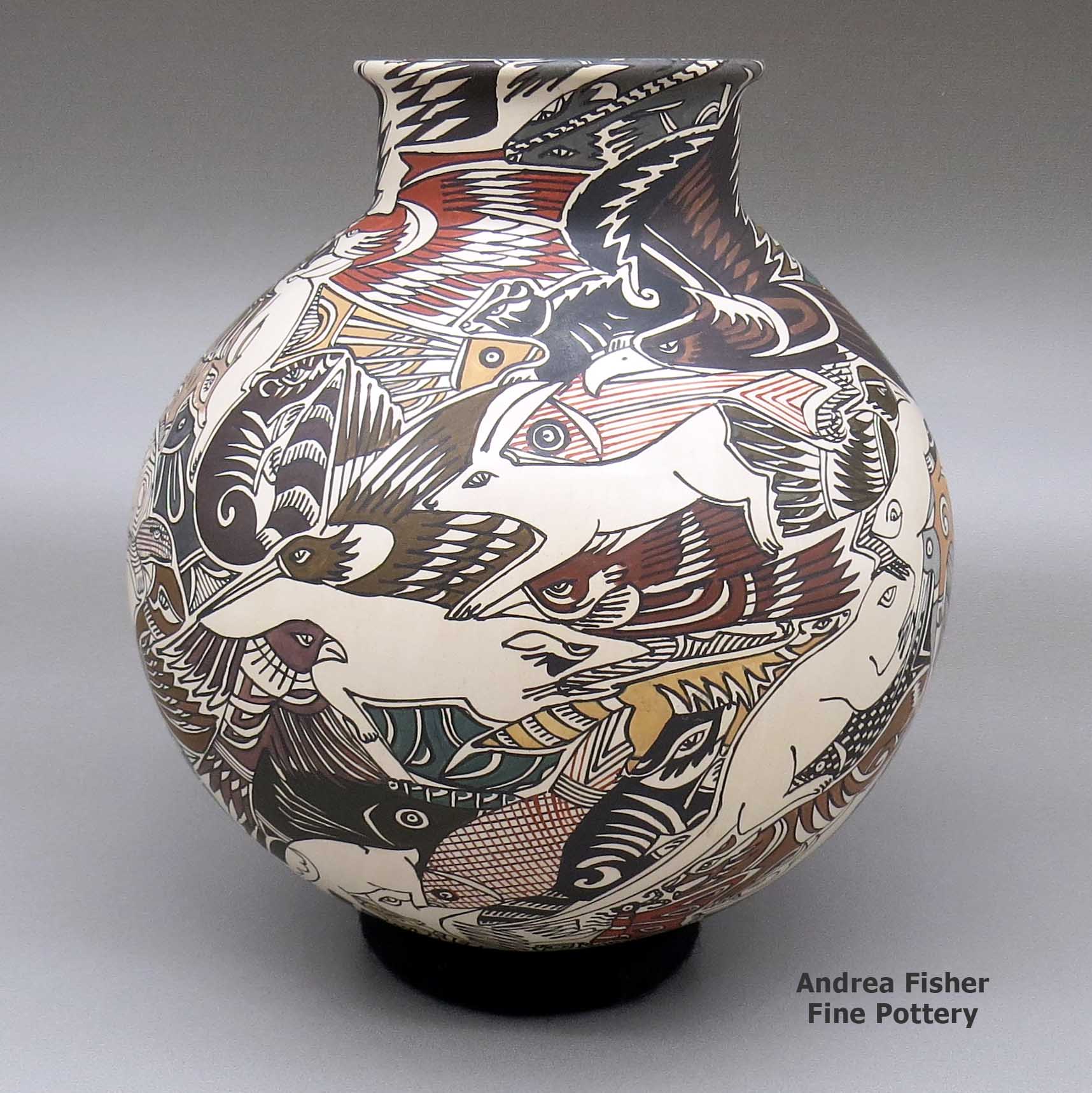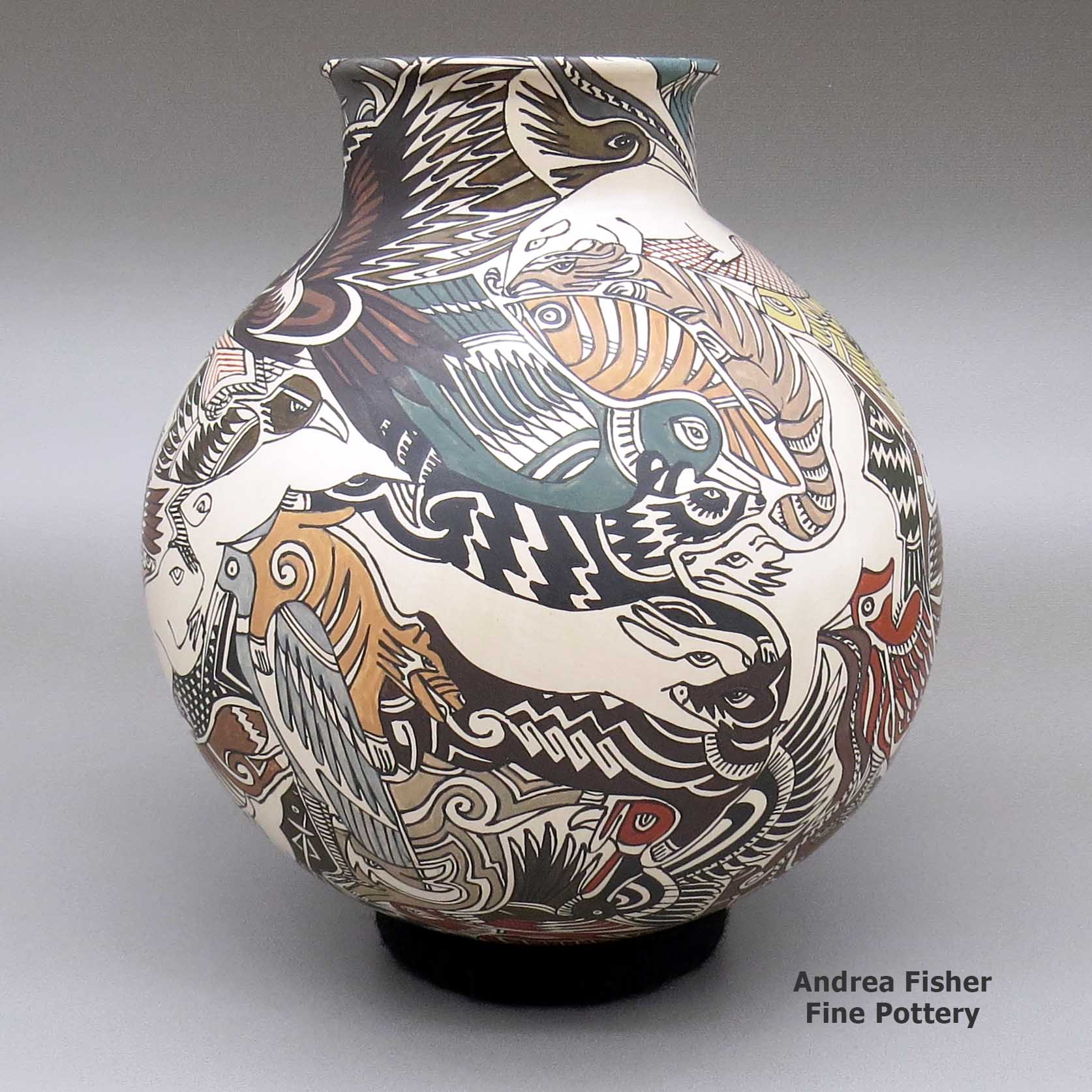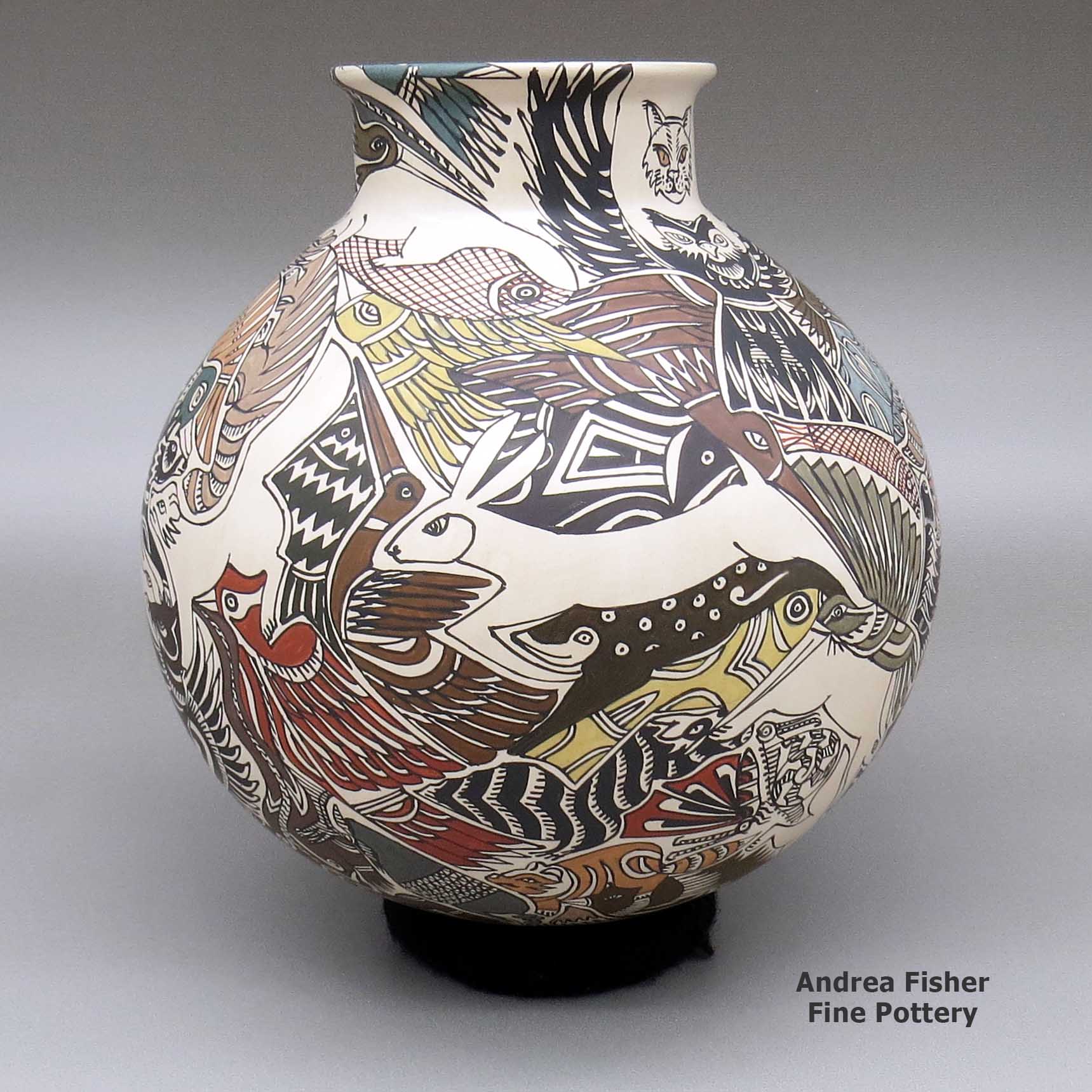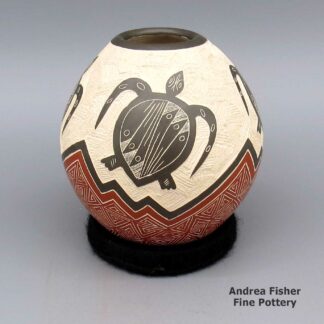| Dimensions | 7.5 × 7.5 × 9.25 in |
|---|---|
| Measurement | Measurement includes stand |
| Condition of Piece | Very good |
| Signature | Manuel Rodriguez Guillen |
Manuel Rodriguez, thcg3c202, Jar with assorted wildlife design
$1,300.00
A polychrome jar with a flared opening and an assorted Paquime wildlife, nature and geometric design
In stock
- Product Info
- About the Artist
- Home Village
- Design Source
- About the Shape
- About the Design
- Teaching Tree
Brand
Rodriguez, Manuel
Early in his career, Manuel became well-known for his Paquimé Revival animal and human figures. Then he moved to making medium-size storage jars and decorating them with complex geometric Escher-like designs that incorporate birds, fish and reptiles.
Many younger potters in Mata Ortiz learned their craft from Manuel.
About Mata Ortiz and Casas Grandes
Mata Ortiz is a small settlement inside the bounds of the Casas Grandes municipality, very near the site of Paquimé. The fortunes of the town have gone up and down over the years with a real economic slump happening after the local railroad repair yard was relocated to Nuevo Casas Grandes in the early 1960s. It was a village with a past and little future.
A problem around the ancient sites has been the looting of ancient pottery. From the 1950s on, someone could dig up an old pot, clean it up a bit and sell it to an American dealer (and those were everywhere) for more money than they'd make in a month with a regular job. And there's always been a shortage of regular jobs.
Many of the earliest potters in Mata Ortiz began learning to make pots when it started getting harder to find true ancient pots. So their first experiments turned out crude pottery but with a little work, their pots could be "antiqued" enough to pass muster as being ancient. Over a few years each modern potter got better and better until finally, their work could hardly be distinguished from the truly ancient. Then the Mexican Antiquities Act was passed and terror struck: because the old and the new could not be differentiated, potters were having all their property seized and their families put out of their homes because of "antiqued" pottery they made just yesterday. Things had to change almost overnight and several potters destroyed large amounts of their own inventory because it looked "antique." Then they went about rebooting the process and the product in Mata Ortiz.
For more info:
Mata Ortiz pottery at Wikipedia
Mata Ortiz at Wikipedia
Casas Grandes at Wikipedia
Contemporary Pottery
The term "contemporary" has several possible shadings in reference to Southwestern pottery. At some pueblos, it's more an indicator of a modern style of carving or etching than anything else. At San Felipe it refers to almost anything newly made there as they have almost no prehistoric templates to work from. At Jemez the situation resolved to where what makes a piece uniquely "Jemez" is the clay. Any designs on that clay can be said to be "contemporary."
About Jars
The jar is a basic utilitarian shape, a container generally for cooking food, storing grain or for carrying and storing water. The jar's outer surface is a canvas where potters have been expressing their religious visions and stories for centuries.
In Sinagua pueblos (in northern Arizona), the people made very large jars and buried them up to their openings in the floors of the hidden-most rooms in their pueblo. They kept those jars filled with water but also kept smaller jars of meat and other perishables inside those jars in the water. It's a form of refrigeration still in use among indigenous people around the world.
Where bowls tend to be low, wide and with large openings, jars tend to be more globular: taller, less wide and with smaller openings.
For a potter looking at decorating her piece, bowls are often decorated inside and out while most jars are decorated only on the outside. Jars have a natural continuity to their design surface where bowls have a natural break at the rim, effectively yielding two design surfaces on which separate or complimentary stories can be told.
Before the mid-1800s, storage jars tended to be quite large. Cooking jars and water jars varied in size depending on how many people they were designed to serve. Then came American traders with enameled metal cookware, ceramic dishes and metal eating utensils...Some pueblos embraced those traders immediately while others took several generations to let them and their innovations in. Either way, opening those doors led to the virtual collapse of utilitarian pottery-making in most pueblos by the early 1900s.
In the 1920s there was a marked shift away from the machinations of individual traders and more toward marketing Native American pottery as an artform. Maria Martinez was becoming known through her exhibitions at various major industrial fairs around the country and Nampeyo of Hano was demonstrating her art for the Fred Harvey Company at the Grand Canyon. The first few years of the Santa Fe Indian Market helped to solidify that movement and propel it forward. It took another couple generations of artists to open other venues for their art across the country and turn Native American art into the phenomenon it has become.
Today's jars are artwork, not at all for utilitarian purposes, and their shapes, sizes and decorations have evolved to reflect that shift.
About Wildlife and Nature Designs
What we're calling "wildlife and nature designs" are usually quite contemporary designs carved, painted and/or etched by hand on a hand-made piece of pottery. In the same genre are bird, butterfly, dragonfly, moth, bat and fish designs. Some have seaweed and vines, some have trunks and branches, some have leaves and/or flowers and/or berries, some don't. Some are composed of optical illusions while others are very clear to the eye. While the designs and layouts tend to be quite contemporary, sometimes they incorporate elements of ancient settings.
Manuel Rodriguez Family and Teaching Tree - Mata Ortiz
Disclaimer: This "family and teaching tree" is a best effort on our part to determine who the potters are in this grouping and arrange them in a generational order/order of influence. Complicating this for Mata Ortiz is that everyone essentially teaches everyone else (including the neighbors), so it's hard to get a real lineage of family/teaching. The general information available is scant. This diagram is subject to change as we get better info.
- Manuel Manolo Rodriguez Guillen (1972- )
- Ricardo Delgado Cruz & Sandra Lorena Arras
- Marta Gonzalez
- Jose Antonio Rodriguez Gonzalez
- Ismael Flores Ledezma
- Ismael Flores Jr.
- Arturo Ledezma
- Efren Ledezma
- Gerardo Ledezma
- Juana Ledezma
- Rafael Ledezma
- Santos Ledezma & Rosa Loya
- Jorge Alejandro Ledezma
- Leticia Ledezma
- Leonel Lopez Sr. & Elena Rodriguez de Lopez
- Abel Lopez
- Leonel Lopez Jr.
- Norma Lopez
- Uriel Lopez and Jesus Rodriguez Guillen
- Maribel Lopez
- Oralia Lopez
- Rosalba Lopez
- Yesenia Lopez
- Hugo Macias
- Alfredo Freddy Rodriguez & Diana Loya
- Emiliano Rodriguez Loya
- Maria Saenz, (Diana's mother)
- Armando Rodriguez & Olivia Mora de Rodriguez
- Abraham Rodriguez
- Luis Armando Rodriguez Students:
- Graciela (Martinez) Gallegos & Hector Gallegos Sr.
- Guadalupe Gallegos (student)
- Hector Gallegos Jr. & Laura Bugarini
- Miriam Gallegos Martinez
- Julio Mora (1971-) & Alma Soto (1974-)
- Oscar Rodriguez Guillen (1970-)
- Ruben Rodriguez & Martha Ponce de Rodriguez
- Teresa Tere Rodriguez






